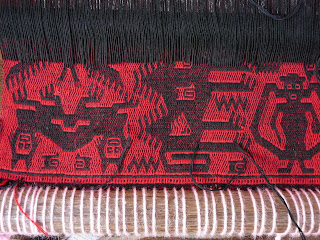
Tarabuco is a tiny, rural pueblo (village) in the Chuquisaca province of Bolivia, about two hours from Sucre. Its main claim to fame is its fine textile design tradition, but it also boasts a fine Sunday market and a really really freaky statue in the center of town.

Bloodlust is alive and well. Take that, first-world tyrants!
Last month I loaded into a precarious bus with a dozen or so other students and clutched the side panels of the rickety vehicle in hopes that the driver wouldn´t pass on every blind turn. I was not lucky on that account, but was treated to a front-seat view of some magnificent landscape and a thrill-ride worthy of an amusement park. My compatriots, in the rear of the bus, were not amused.

The collective heat of this arrangement defies all logic
Like most Bolivian pueblos and campos, Tarabuco is incredibly poor, at least economically speaking. What it has a wealth of are extra-spicy peppers, vendors and traders of every stripe, and especially intricate woven goods.

Garments like these are still worn today (ASUR image)
While I was visiting I got a chance to watch a metalsmith hammer a pick-axe into fine form, meet a cobbler with a wicked sense of humor, and see a grown man muscle a freshly slaughtered pig down a narrow alleyway. I felt like I´d truly arrived!

A modern day Hephaestus

My kicks have seen better days

Give this man a wide berth
I´ve always loved fabric, and this leg of the trip has been a real treat. Some of my very earliest memories are of my mom carding wool, showing me how to drop spin, and weaving on a beautiful Swedish loom that took over our kitchen.
My current favorite textiles feature a character called El Supay. By various turns he´s considered the lord of liminal spaces, the son of Pacha Mama or Tierra Madre (Earth Mother), or, to Spanish conquistadors, El Diablo. In the delicately constructed fiber-arts of this region, El Supay holds sway over a subteranean world of fantastical creatures. Multi-winged griffins mingle with double-headed horses, strange rabbits, and condors. These masterpieces take months to construct and the very finest are displayed at ASUR, a museum of indigenous textile art on Calle San Alberto.

Slightly chaotic, totally captivating
The Jalq´a and Tarabuco weaving tradition is far from dead. A renaissance of sorts is underway where the oral tradition of textile design is being passed from older women to young girls who have found a passion for their craft. Men, too, have become excited by weaving and have developed a unique style of their own. The art and technology of weaving has remained the same for centuries, while designs have continued to evolve. The new work being done now is a reflection of each weaver´s imagination, not a duplication of previous forms.

Colorful work in progress

A young artisan at ASUR

El Supay detail
From the ASUR website:
Tarabuco was situated on the former Inca border with [other] groups farther east. To guard this border from constant invasions, especially by the Chiriguanos, the Inca moved warriors from several different provinces into this area... at some point the descendants of these different groups began to adopt similar customs and dress which, in spite of minor differences in the design of certain garments, gave them a common appearance.

Local performer at lunch

Hole-in-the-wall restaurant in Tarabuco

Sunday shoppers, outside

Inside, a maze of cebollas y zanaorria (onions and carrots)



No comments:
Post a Comment